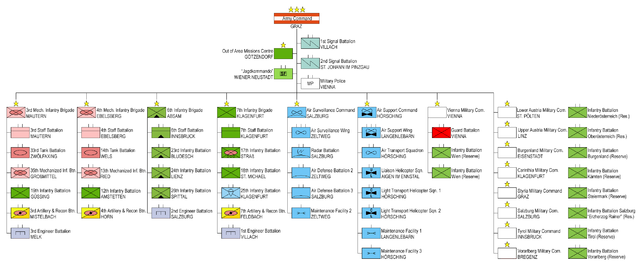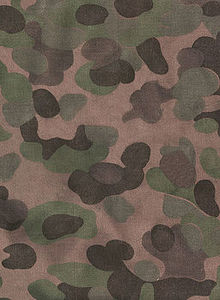Austrian Armed Forces
| Austrian Armed Forces | |
|---|---|
| Österreichs Bundesheer | |
 Leopard 2A4 of the Bundesheer | |
| Service branches | Land Forces Air Forces |
| Headquarters | Vienna |
| Leadership | |
| Commander-in-Chief | President Heinz Fischer |
| Minister of Defence | Norbert Darabos |
| Chief of Defence | General Edmund Entacher |
| Personnel | |
| Military age | 18 |
| Conscription | 6 months |
| Available for military service | 1,914,800 males, age 16-49, 1,870,134 females, age 16-49 |
| Fit for military service | 1,550,441 males, age 16-49, 1,515,365 females, age 16-49 |
| Reaching military age annually | 48,967 males, 46,633 females |
| Active personnel | 31,000 |
| Reserve personnel | 24,000 |
| Expenditure | |
| Percent of GDP | 0.9% (2004) |
| Industry | |
| Domestic suppliers | Steyr Mannlicher Steyr-Daimler-Puch Spezialfahrzeuge (General Dynamics) |
| Foreign suppliers | |
| Related articles | |
| History | Military history of Austria Austro-Hungarian Army |
The current name of the Military of Austria is Österreichs Bundesheer ("Federal Army of Austria", official English name Austrian Armed Forces). Between 1918 and 1921, the Austrian semi-regular army was called Volkswehr ("People's Defence"), and fought against Yugoslavian army units occupying parts of Carinthia. It has been known as "Bundesheer" since then, except when Austria was a part of Nazi Germany (1938-1945; see Anschluss). The Austrian Army did develop a defence plan in 1938 against Germany, but politics meant it was never implemented.
In 1955, Austria declared its Everlasting Neutrality and made neutrality a constitutional law. The Austrian Military's main purpose since then has been the protection of Austria's neutrality. The main branches since the last structural reform are the Land Forces (Kommando Landstreitkräfte; KdoLaSK), Air Forces (Kommando Luftstreitkräfte; KdoLuSK), Mission Support (Kommando Einsatzunterstützung; KdoEU), International Missions (Kommando Internationale Einsätze; KdoIE), Command Support (Kommando Führungsunterstützung; KdoFüU) and Special Forces (Kommando Spezialeinsatzkräfte; KdoSEK).
With the end of the Cold War, the Austrian military have increasingly assisted the border police in controlling the influx of illegal immigrants through Austrian borders. The war in the neighbouring Balkans resulted in the lifting of the restrictions on the range of weaponry of the Austrian military that had been imposed by a 1955 international treaty.
The main constitutional tasks of today's Austrian military are:
- to protect the constitutionally established institutions and the population's democratic freedoms.
- to maintain order and security inside the country.
- to render assistance in the case of natural catastrophes and disasters of exceptional magnitude.
Equipment

The Austrian military has a wide variety of equipment. Recently, Austria has spent considerable amounts of money modernizing its military arsenal. Leopard 2 main battle tanks, Ulan and Pandur infantry fighting vehicles, C-130 Hercules transport planes, S-70 Black Hawk utility helicopters, and Eurofighter Typhoon multi-purpose combat aircraft have been purchased, along with new helicopters to replace the inadequate ones used after the 1999 Galtür Avalanche.
Austria's current equipment includes:
- 114 Leopard 2 main battle tanks.
- 253 Steyr SK-105 Kurassier Light Tanks.
- 465 Saurer APC Armoured personnel Carriers
- 189 M109 howitzer.
- 70 Bergepanzer Armoured repair and recovery vehicles.
- 18 A1 Armoured engineer vehicles.
- 86 Jaguar 1 Tank destroyers.
- 112 Ulan infantry fighting vehicles (end of 2005).
- 224 Pandur APCs.
- 35 Dingo 2 Protected vehicles.
- 268 Mercedes-Benz Unimog Trucks.
- 307 MAN 12.240 Trucks.
- 27 Observation tanks.
- 3 Lockheed C-130 Hercules transport planes.
- 9 Sikorsky S-70 Black Hawk utility helicopters (purchased in 2001).
- 16 Pilatus PC-7 Turbo Trainer Training aircraft.
- 13 Pilatus PC-6 Porter Transport aircraft.
- 2 Short Skyvan Transport aircraft.
- 23 Alouette Recovery helicopters.
- 23 Agusta Bell 212 Twin Huey utility helicopters.
- 12 Bell OH-58 Kiowa Scout helicopter
- 11 Bell 206 JetRanger Training helicopters.
- 28 Saab 105 aircraft.
- 12 Northrop F-5E/F Tiger fighter aircraft (on loan from the Swiss Air Force).
- 15 Eurofighter Typhoon
Infantry weapons

- Steyr AUG (service rifle)
- Glock 17 (main Sidearm)
- Stg 58 (Austrian licensed FN-FAL, former service rifle)
- Steyr GB (former service sidearm)
- Browning Hi-Power (former service sidearm)
- Walther P38 (former service sidearm)
- Steyr MPi 69 and 80 sub-machine guns
- Steyr TMP submachine gun
- MG 74 multi purpose machine gun
- Steyr SSG 69 (standard sniper rifle)
- PAL 2000 (Bofors Bill) anti-tank
- PAR 66 (Bofors Carl-Gustaf) anti-tank
Traditions

Some of the traditions of the old Austro-Hungarian Army continue to be carried on in Bundesheer. For example, the most famous regiment in the Bundesheer is the "Hoch und Deutschmeister Regiment", now known as Jägerregiment Wien based in "Maria Theresien Kaserne", named after Empress Maria Theresa of Austria. Also nearly every other regiment of the Bundesheer carries on traditions of the famous Austro-Hungarian regiments like "Kaiserjäger", "Rainer", etc.
Austrian commando frogmen
Austria's combat frogmen are part of the commando group of the Austrian federal army, the so-called Jagdkommando. The commando group is available for special operations in multinational operations, and for operational clearing-up in remote reconnaissance employments and in military protection of individuals abroad.
They use the Dräger LAR-V oxygen rebreather, which weighs 11 Kg and has a 1.5 liter oxygen cylinder and allows a dive 3 hours long.
Beyond that they have special tasks within the range of combat frogmen, the paratroops, and personal guards.
| Conditions for training as a frogman | Courses covered by frogman training | Further courses |
|---|---|---|
|
|
|
External links
- Template:De icon http://tauchen.nullzeit.at/Content.Node/wissenswertes/kampfschwimmer_bundesheer.php
- Template:De icon http://www.doppeladler.com/oebh/jakdo.htm
- Template:De icon http://www.doppeladler.com/oebh/jakdo.htm?jakdo_02.htm
References
- CIA World Factbook, 2005
